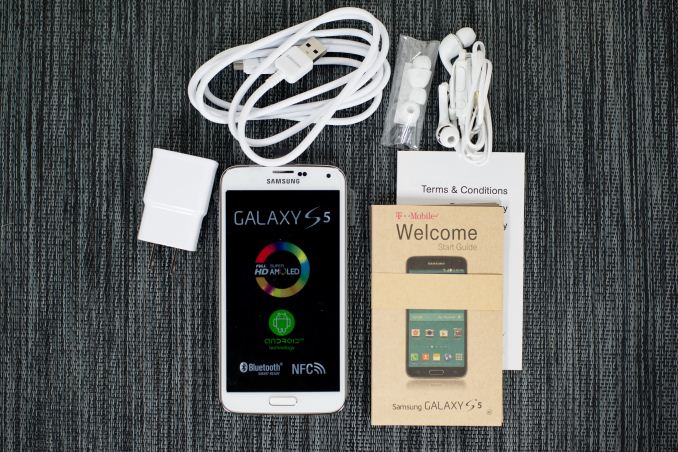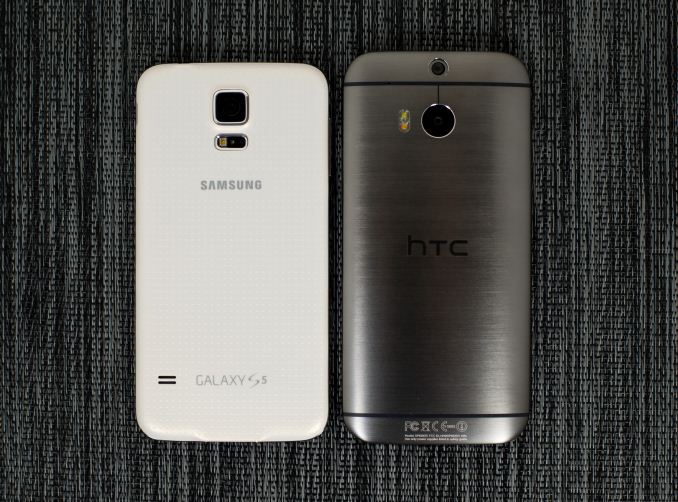Samsung Galaxy S 5 Review
by Anand Lal Shimpi & Joshua Ho on April 8, 2014 12:00 AM EST- Posted in
- Smartphones
- Samsung
- Mobile
- Galaxy S 5
Final Words
The Galaxy S 5 is a healthy update to the series. With the Galaxy Note 3's release last year we saw a device that ultimately became the new flagship from Samsung. The GS5 takes the crown back for those users who want a more reasonably sized device.
The GS5 sees upgrades across the board compared to its predecessor. The underlying silicon is both faster and more power efficient. The battery is larger, and battery life has improved dramatically thanks to silicon and display upgrades. Much like the gains we saw with HTC's M7 to M8 transition, anyone who is on a Snapdragon 600 based device today is going to be incredibly happy upgrading to a Snapdragon 801 platform like the GS5.
Connectivity sees a boost with the addition of Qualcomm's envelope tracker and support for carrier aggregation on LTE. The inclusion of 2x2 MIMO 802.11ac brings WiFi performance to a new level with the GS5.
The move to Samsung's own 16MP rear facing camera sensor brings about an increase in spatial resolution, and some improvements in low light performance compared to the Galaxy S 4. I'm not totally sold on the GS5's image processing but the overall camera experience is pretty solid. I would still like to see Samsung move to a slightly lower resolution sensor with larger pixels to provide a more balanced solution. As of now the GS5 is a solid shooter outdoors and with decent light, but indoors and in low light solutions it struggles.
NAND performance is about the only downside to the GS5's hardware upgrade, mainly in that it seems to ignore random read/write performance in favor of sequential gains. Anyone who has followed our SSD coverage at AnandTech should know the issues with this approach.
Display is also dramatically improved from the Galaxy S4. Samsung's AMOLED panels have finally caught up with LCD in most of the key metrics while retaining the key advantages of AMOLED such as infinite contrast and higher power efficiency at lower average picture level.
It's not all hardware upgrades that makes the GS5 what it is. Samsung did an excellent job of cleaning up its UI from the crowded mess that we saw in GS4 to something much more polished. It's not perfect, but a huge step in the right direction. While the GS4 felt more like feature creep for use in marketing materials, the GS5's software is far better executed.
There are even some nifty additions that can come in handy. Ultra low power saving mode is one in particular that seems to have a measurable impact on battery life if you're willing to give up some performance.
Overall the Galaxy S 5 is a solid replacement to the GS4 (and definitely to any previous Samsung device). I find that pretty much all the flagships offer some set of tradeoffs that prevent any one from being the perfect device (iPhone's screen size, GS5's materials, M8's camera). It's unfortunate because I'd really like to crown a single device the king of them all, but instead we're faced with a handful of differing optimization points. Samsung got it almost perfect with the GS5. With a metal body, a rear facing camera with larger pixels (perhaps with some tweaks to camera output processing), a better NAND controller, and stereo front facing speakers, the GS5 would probably be perfect.












296 Comments
View All Comments
Saltank - Wednesday, April 9, 2014 - link
Not a single word about actually making phone calls? No call quality / HD Voice stuff? I was awestruck by how awesome my iPhone 5 handles regular non-HDVoice calls, and the GS3 was good, too, but my old HTC One was subpar.Also, how come camera comparisons don't take WP's in to account? No Lumia 1020/1520/930?
Lightstorm66 - Wednesday, April 9, 2014 - link
I thought Anandt ech knew that the Samsung Browser is faster than chrome and achieves in the Galaxy S5 even better results than the iphone 5s in sunspider.Galaxy S5: 385,8 ms
iphone 5s: 414,7 ms
ryanmt - Wednesday, April 9, 2014 - link
The LG G2 is the unsung camera hero here. It outperforms it all. Why are only the HTC M8 and 5S called out for their good low light performance when the G2 is actually (subjectively) better?echo9251 - Wednesday, April 9, 2014 - link
There should be more talk about the lack of a 64MB option. I have a 64MB HTC One (M7) and enjoy never having to worry about running out of storage for apps, etc. Losing half my storage is a big disincentive to "upgrading" to a new phone.Brian Z - Wednesday, April 9, 2014 - link
Well they did include a micro SD card that supports up to 128gb.I am not going to make the case that having more storage considering the outrageous prices of the these devices. But at a point it gets a ridiculous. People complain loud OMG no external storage. No buy. Then they make 32gb device with expandable storage. People still complain
Streamlined - Thursday, April 17, 2014 - link
Uh, because SD cards are dog slow compared to storage on the motherboard. SD CARDS SUCK and that is why HTC includes larger storage options. Just another reason the M8 is the best Android phone money can buy.Myrandex - Wednesday, April 9, 2014 - link
I'm disappointed no Nokia's showed up in the camera tests. I've love to see how this lined up with my Lumia 920, particularly in the low light tests. My wife's 1020 is a beast too.Souka - Wednesday, April 9, 2014 - link
Here's a another way to test durability and take apart a S5https://www.youtube.com/watch?v=newNF1UsOcw
dlang1234 - Wednesday, April 9, 2014 - link
What I'm most impressed by, is how well the LG G2 is performing at these benchmarks against much newer phones. I have had my G2 for a while now, and it is an awesome phone.. so much so that these phones look more like side grades than upgrades even though, I mean it was released September 12, 2013 and now almost 6 months later, the epic increases of speed in mobile seems to be subsiding some.chrcoluk - Wednesday, April 9, 2014 - link
agreed.I own a S3 and a galaxy ace.
The galaxy ace has cyanogen mod 7.2 installed on it.
The S3 has touchwiz based on android 4.3
In terms of hardware spec the S3 is many multiples more powerful than the ace.
However many basic functions are much snappier on the ace, in particurly using it as a phone, bringing up the call log, scrolling the call log, making calls, answering calls, opening contacts, all these functions much faster on the ace. The ace also wakes up immediatly whilst the S3 has wake lag, the ace has much longer lasting battery even tho it has a weaker battery. However the ace does suck when it comes to using it for the internet/gaming most 3rd party apps as thats where its hw spec hits it, but its limitations are mostly down to its lack of ram. IT seems to always have more spare cpu cycles than the S£ as the S3 is bogged down by touchwiz.
So why havent I got the S3 on AOSP. google edition etc? the problem is the contacts/dialer app on AOSP sucks really bad, its aweful. Especially with the default white background. Samsung have at least maintained a half decent UI design in their dialer/contacts the problem is its mega laggy. But sadly UI design wins over performance. CM7.2 has the best ever dialer/contacts I have seen on a android phone but new phones cannot use CM7.2.
I have recently decided to start using the ace as my main phone (its easier to use out and about also due to its smaller size) and primarily use the S3 as a portable computing device. That way I can stick AOSP on the S3 and not worry about the crappy contacts app.
Do samsung deliberatly make their interface laggy? not sure, its certianly possible tho as they want to give a people a reason to upgrade to the next phone every year.
Also notice how every new software update increases the fotn size as well, to give people a reason to want the higher DPI. The relative font size looks equal on my ace vs the S3 even tho the S3 has a way higher resolution.